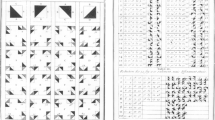Abstract
Given a collection of regions on a map, we seek a method of continuously altering the regions as the scale is varied. This is formalized and brought to rigor as well-defined problems in homotopic deformation. We ask the regions to preserve topology, area-ratios, and relative position as they change over time. A solution is presented using differential methods and computational geometric techniques. Most notably, an application of this method is used to provide an algorithm to obtain cartograms.










Similar content being viewed by others
Notes
This function might be non-differentiable at a few places, and thus needs to be replaced by an arbitrarily close differentiable one. Geometrically, this can be viewed as smoothing of the corners of the medial axis.
Unlike the Voronoi regions defined in Eq. 1, we are not interested in the boundary \({\partial} {\Omega}\) now.
It is necessary to separate the regions with some space. To do this we remove from each set A i a small δ-neighborhood of \(\partial A_i\). The resulting regions (still denoted as A i ) leaves every pair of regions separated by at least 2δ. As always, we smooth out corners of the regions so that their boundaries are differentiable.
Two regions are arbitrarily close if the distance between the corresponding points of the regions are within some small ε > 0 of each other.
References
de Boor C (2001) A practical guide to splines, revised edn. Springer, New York
Edelsbrunner H, Waupotitsch R (1997) A combinatorial approach to cartograms. Comput Geom 7:343–360
Gastner M, Newman M (2004) Diffusion-based method for producing density-equalizing maps. Proc Natl Acad Sci 101:7499–7504
Goodman J, O’Rourke J (eds) (2004) Handbook of discrete and computational geometry, 2nd edn. CRC, New York
Hatcher A (2002) Algebraic topology. Cambridge University Press, New York
Hoff K, Culver T, Keyser J, Lin M, Manocha D (1999) Fast computation of generalized Voronoi diagrams using graphics hardware. In: International conference on computer graphics and interactive techniques, pp 277–286
Jones C, Ware J (2005) Map generalization in the web age. Int J Geogr Inf Sci 19:859–870
Lam N, Catts D, Quattrochi D, Brown D, McMaster R (2004) Chapter 4: scale. In: McMaster R, Lynn Usery E (eds) A research agenda for geographic information science. CRC Press, pp 93–128
Okabe A, Boots B, Sugihara K (1992) Spatial tessellations: concepts and applications of Voronoi diagrams. John Wiley and Sons, New York
Saalfeld A (1996) Consistent map generalization via white space management (preprint)
Sester M, Brenner C (2006) Continuous generalization for small mobile displays. In: Next generation geospatial information. Taylor and Francis Group, London, pp 33–41
Tobler W (2004) Thirty five years of computer cartograms. Ann Assoc Am Geogr 94:58–73
van Kreveld M (2001) Smooth generalization for continuous zooming. In: Proceedings 20th international geographic conference, pp 2180–2185
van Oosterom P (2005) Variable-scale topological data structures suitable for progressive data transfer: the GAP-face tree and GAP-edge forest. Cartogr Geogr Inf Sci 32:331–346
Ramanathan M, Gurumoorthy B (2003) A tracing algorithm for constructing medial axis transform of 3D objects bound by free-form surfaces. CAD 35:619–632
Yang W, Gold C (1997) A system approach to automated map generalization. In: Proceedings: international workshop on dynamic and multi-dimensional GIS, pp 229–235
Acknowledgements
We are grateful to the NSF for partially supporting this project with grants DMS-0353634 and CARGO DMS-0310354. We thank Tamal Dey, Chris Jones, Marc van Kreveld, Alan Saalfeld, Jim Stasheff and Robert Weibel for helpful conversations. Satyan Devadoss also wishes to thank Jörg-Rüdiger Sack, Monika Sester, Peter van Oosterom, and Michael Worboys for organizing the Dagstuhl workshop on Spatial Data in 2006, which motivated and solidified several concepts in this work. Finally, the authors thank the anonymous reviewers for their insightful comments and corrections.
Author information
Authors and Affiliations
Corresponding author
Rights and permissions
About this article
Cite this article
Danciger, J., Devadoss, S.L., Mugno, J. et al. Shape deformation in continuous map generalization. Geoinformatica 13, 203–221 (2009). https://doi.org/10.1007/s10707-008-0049-0
Received:
Revised:
Accepted:
Published:
Issue Date:
DOI: https://doi.org/10.1007/s10707-008-0049-0




